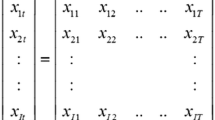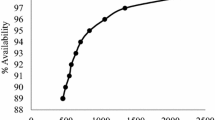Abstract
In the Gas Turbine Power Plant industry, the effective maintenance strategy will solve the fast cost-effective responses to unpredictable and ever-changing plant shutdowns. Continued pressure on companies to reduce costs and improve customer satisfaction has resulted in increasingly detailed examinations of maintenance strategies. A judiciously selected maintenance program can provide significant advantages in relation to quality, safety, availability, and cost reduction in these plants. A wrong decision can lead to the failure of the components and consequent economic losses. Therefore, justification of any given maintenance strategy within an organization must consider cost and other related criteria viz availability, criticality of machines (CM), maintenance support facility (MSF). The purpose of this study is to select the apposite maintenance strategy based on these criteria to improve the availability of power plant. The analytical hierarchy technique is used to come to the appropriate selection of maintenance strategy.
Access provided by Autonomous University of Puebla. Download conference paper PDF
Similar content being viewed by others
Keywords
1 Introduction
There are various types of maintenance programs that power plants can use by selecting a right maintenance strategy [1]. Hence the decision of determining the strategy for power plant machinery maintenance is most significant. There is a dearth of development and applicability of an Analytical Hierarchy process (AHP) in selecting maintenance strategy for power plants [2]. In this section the selection of maintenance strategy for power plants has therefore been presented using the analytical hierarchical process. Decisions associated with determining appropriate machine maintenance require the integration of (1) commercial (2) engineering (3) operational (4) safety, health, and environmental (SHE) issues. The important factors identified in maintenance strategies are criticality of machines (CM), Cost (C), availability (A), reliability (R),maintainability (M), maintenance support facility (MSF), SHE, condition monitoring facility, ease of maintenance [3, 4]. A set of questionnaires are designed and a survey was made from the respondents about their opinions. A five-point scale is used for each of the factor/criteria relating to the equipment selection problem (Fig. 1) and the respondents were asked to rate [5, 6].
2 Literature Review
A manufacturer’s overall business success will be determined by the following integrated dimensions of performance: fitness of the manufacturer’s products for use and their producibility. History has left the development and management of availability performance with great room for advancement. In this respect, design of the best maintenance strategy will play a great role. Researcher Richard G Lamb has given importance of Availability engineering and management for manufacturing plant performance in the year 1964. The researcher Suleyman Ozekci pointed out that the deterioration and failure process depends on the environment so that the failure rate at any time is a function of the prevailing environmental state. This necessitates the use of the intrinsic age of a device, rather than the real age, in reliability and maintenance problems n view of the fact that choosing of the most suitable maintenance strategy for different equipment is a crucial decision for managers, a large number of studies have been devoted to this field of research. In the literature, Murthy and Asgharizadeh (1999) [7] recommended a methodology based on game theory for selection of maintenance strategy for the companies which outsource the maintenance operations. Almeida and Bohoris (1995) [8] discussed a brief review of different decision theory concepts along with their applicability in the choosing of the most appropriate maintenance strategy. Bevilacqua and Braglia (2000) [9] proposed a multi criteria decision making (MCDM) method based on AHP. In this research sufficient attributes have been considered in the form of a crisp MCDM method. Bertolini and Bevilacqua (2006) [10] selected maintenance strategy for a set of centrifugal pumps used in an Italian oil refinery by using a hybrid method of goal programming and AHP. Al-Najjar and Alsyouf (2003) [11] proposed a combination of fuzzy inference system (FIS) and simple additive weighting (SAW), with considering a few failure causes as attributes, to make the optimum decision about maintenance strategy. Azadivar and Shu (1999) [12] proposed a new method considering 16 different characteristic parameters as criteria for each class of systems in a just-in-time environment. Gaonkar et al. (2008) [13] and Wang et al. (2007) [14] present a fuzzy AHP approach to model the uncertainty in the choosing process of the optimum maintenance strategy.
3 Methodology Used
A five-point scale is used for each of the factor/criteria relating to the equipment selection problem (Fig. 1):
-
(1)
Respondents were asked to rate each factor how they liked each using the above scale.
-
(2)
Mean value of each factor/criteria is calculated as follow:
-
(3)
The mean value of each factor = ∑x i f i /N , where x i number of respondents corresponding to rate associated with a particular factor, f i corresponding value/rate of that particular factor, N—Total no of respondents. The results of survey are given in Fig. 2.
-
(4)
Cut-off value is determined taking the mean of highest (4.8) and the lowest (1.2) mean rating value of all factors considered in survey.
-
(5)
Mean rating value of the factors above the cut-off value (Fig. 2) are considered as important criteria or factors for selection of maintenance strategy. The following factors/criteria are found important. CM, COST(C), Availability (A), Reliability (R), Maintainability (M), MSF, SHE.
4 Case Study
4.1 Selection of Maintenance Strategy
For this purpose of selection of appropriate maintenance for power plant machinery in plant five alternative maintenance strategies such as M1, M2, M3, M4, and M5 have been taken [15]. Five maintenance alternatives ( M, i = 1, 2,…, 5) are then evaluated by AHP [16] model in terms of the criteria. Figure 3 presents the systematic procedure to understand the hierarchy for problems. The types of maintenance alternatives are: corrective maintenance, preventive maintenance (PM), total productive maintenance (TPM), reliability centered maintenance (RCM), Terotechnology.
5 Results
Table 1 presents the pair wise comparison matrix of Criteria and Fig. 4 presents the importance.
Table 2 also gives the overall rating of each maintenance. It is seen from Table 2 and Fig. 5 that maintenance alternative M4 (with rating of 0.3588) is the most preferred one considering above seven criteria followed by maintenance M1, M2, M5, M3. That means RCM > Corrective maintenance > PM > Terro technology > TPM. That is, RCM is the best maintenance under the following criteria.
6 Concluding Remarks
Categorization of maintenance strategy for selection of appropriate maintenance decision making is very important, AHP is sound surrogate to make it possible to rank maintenance strategy. The AHP model is also unique in determining the machine criticality. Though the suggested methodology is applied to determine the best maintenance strategy and power plant machinery criticality determination for formulation of maintenance decision making, there is nothing unique about the environment and hence this approach can be generalized to any industry or plant. Similarly, we can determine the critical components of the particular machine for the purpose of maintenance decision making. By the exercise carried out in this paper it is found that reliability centered maintenance is the best maintenance strategy.
References
Carter ADS (1986) Mechanical reliability, 2nd edn. Macmillan, London
Samanta B, Sarkar B, Mukherjee SK (2002) An application of AHP for selection of maintenance personnel in mine. J Mines Met Fuels Appeared
Lamb GR (1995) Availability engineering and management for manufacturing plant performance, Prentice hall Inc
Ozekici S (1995) Optimal maintenance policies in random environments. Eur J Oper Res 82:283–294
Sastry GVYN (1997) Maintenance management of heavy earth moving machinery. Indian Min Eng J 36(8):27–28
Schottl A (1996) A reliability model of a system with dependent components. IEEE Trans Reliab 45(2):267–271
Murthy DNP, Asgharizadeh E (1999) Optimal decision making in a maintenance service operation. Eur J Oper Res 116:259–273. doi: 10.1016/S0377-2217(98)90202-8
Almeida AT, Bohoris GA (1995) Decision theory in maintenance decision making. Qual Maintenance Eng 1(1):39–45. doi:10.1108/13552519510083138
Bevilacqua M, Braglia M (2000) The analytic hierarchy process applied to maintenance strategy selection. Reliab Eng Syst Saf 70(1):71–83. doi: 10.1016/S0951-8320(00)00047-8
Bertolini M, Bevilacqua M (2006) A combined goal programming–AHP approach to maintenance selection problem. Reliab Eng Syst Saf 91(7):839–848. doi:10.1016/j.ress.2005.08.006
Al-Najjar B, Alsyouf I (2003) Selecting the most efficient maintenance approach using fuzzy multiple criteria decision making. Int J Prod Econ 84(1):85–100. doi: 10.1016/S0925-5273(02)00380-8
Azadivar F, Shu V (1999) Maintenance policy selection for JIT production systems. Int J Prod Res 37(16):3725–3738. doi: 10.1080/00207549919001
Gaonkar RSP, Verma AK, Srividya A (2008) Exploring fuzzy set concept in priority theory for maintenance strategy selection problem. Int J Appl Manage Technol 6(3):131–142
Wang L, Chu J, Wu J (2007) Selection of optimum maintenance strategies based on a fuzzy analytic hierarchy process Int J Prod Econ 107(1):151–163. doi: 10.1016/j.ijpe.2006.08.005
Taha HA (1977) Operation research, an introduction, 6th edn. Prentice hall
Tam CY, Tyummala VMR (2001) An application of the AHP in vendor selection of a telecommunication system, omega. Int J Manage Sci 29:171–182
Author information
Authors and Affiliations
Corresponding author
Editor information
Editors and Affiliations
Rights and permissions
Copyright information
© 2012 Springer India
About this paper
Cite this paper
Sarkar, A., Behera, D.K. (2012). Design of Optimal Maintenance Strategy. In: Sathiyamoorthy, S., Caroline, B., Jayanthi, J. (eds) Emerging Trends in Science, Engineering and Technology. Lecture Notes in Mechanical Engineering. Springer, India. https://doi.org/10.1007/978-81-322-1007-8_35
Download citation
DOI: https://doi.org/10.1007/978-81-322-1007-8_35
Published:
Publisher Name: Springer, India
Print ISBN: 978-81-322-1006-1
Online ISBN: 978-81-322-1007-8
eBook Packages: EngineeringEngineering (R0)









